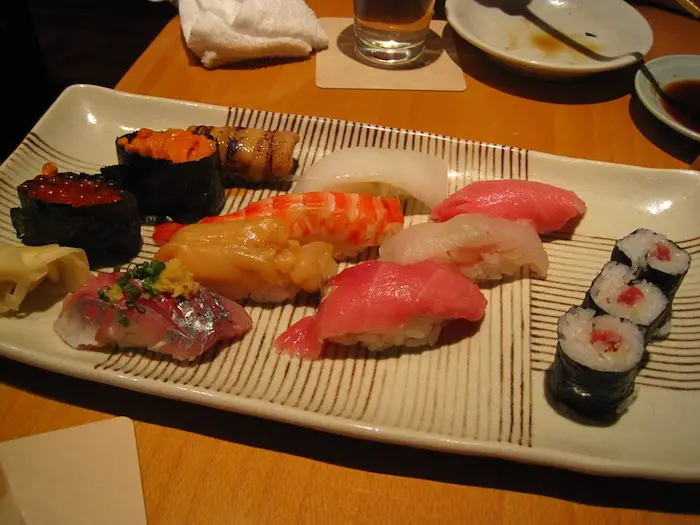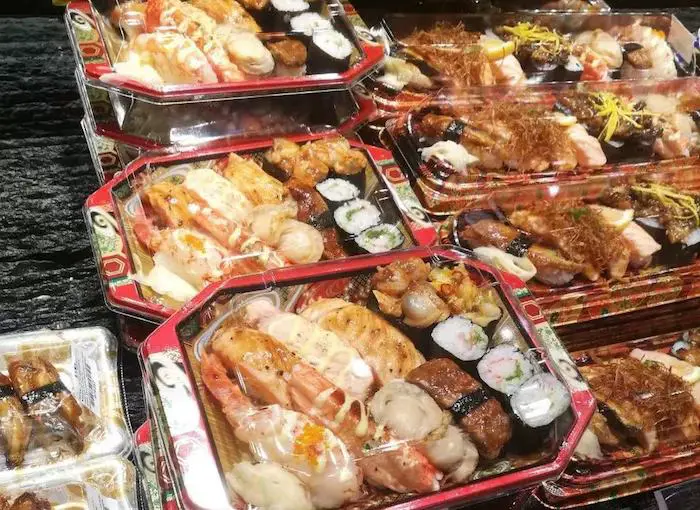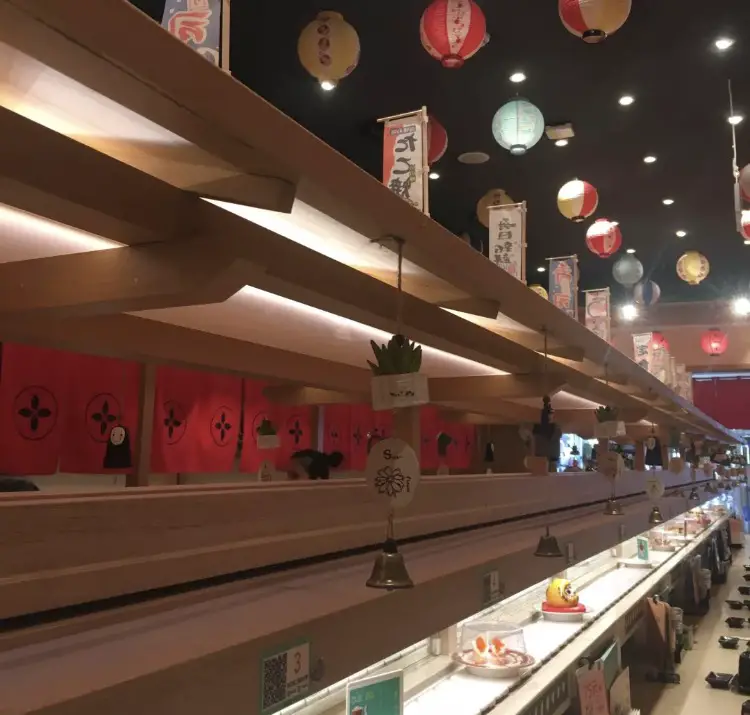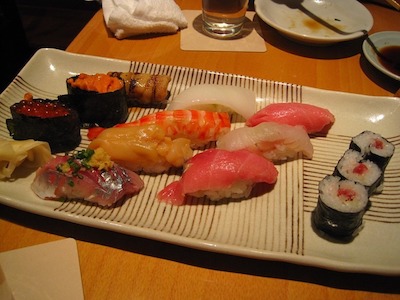We are reader supported. When you purchase through links on our site, we may earn an affiliate commission. Also, as an Amazon affiliate, we earn from qualifying purchases.

I must admit that traditional sushi art and presentation skills of the master chefs always leave me in awe. While I enjoy indulging in an elaborate sushi meal on special occasions, I can’t deny that a quick spicy tuna roll from the grocery store sometimes feels like a life savior on my way home from the office.
So, does sushi count as fast food? I would say both yes and no. The widespread sushi culture has made it a popular item at grocery stores where you can grab a California roll like a burger or fries without having to sit down for a meal. However, labeling sushi as fast food may be degrading for a fine delicacy where so much care is put into preparing the ingredients and assembling.
Let’s not forget that this is a traditional Japanese delicacy where the emphasis is on quality, not quantity. The sushi traditionalists may be offended even if we compare sushi with fast food. However, it cannot be denied that the dish has evolved considerably and the western influence can be seen in everything from the choice of fillings to the way sushi is served or eaten.
I am sure every sushi lover dreams of an omakase or a robust sushi meal, but long wait lines and rush hours may make us grab a takeaway every now and then. To better understand whether or not sushi counts as fast food, let me present a few arguments both for and against it.
Things That Make Sushi A Fast Food
If you look into the Wikipedia definition of ‘fast food’, it says this is a kind of mass-produced food that is created for commercial resale and there’s more priority on ‘speed of service’. The concept of fast food was developed as a commercial strategy to cater delicious food quickly to a large number of busy travelers, commuters, and wage workers who did not have the time to sit down and eat or wait for the food.
Now, let’s take a look into how sushi evolved. It first started as a means to preserve fish and rice was used to ferment with it. When the fish was ready to eat, the fermented rotten rice was discarded and only the fish was eaten. This type of food was called namanari.
After vinegar was created, people started using vinegar to ferment in less time and the rice was also consumed with fish. In this case, the rice was eaten before it becomes rotten and the fish was also partly raw. Instead of being a medium of preservation, the rice was used as a part of the dish called narezushi.
The Edo period saw the popularity of a new type of dish called haya sushi. In English it means ‘fast sushi’ and in this method, rice and fish was assembled together to be consumed at the same time. Rice was typically seasoned with vinegar and topped up with fish, vegetables or dried food.
In the 19th century, several mobile food vendors opened up in Edo (now known as Tokyo) and they started selling a type of fast food known as nigirizushi, originally created by Hanaya Yohei. It comprised of an oblong-shaped bed of rice with tuna or other fish on the top.
Even hundreds of years ago, the meticulous Japanese lived a very busy life and nigirizushi became a fast food that people could eat without wasting much time. In 1923, Edo sushi chefs spread throughout Japan to popularize the sushi culture in different parts of the country.
Fast forward to the present day and we have so many different types of sushi not only in Japan but across the world. It won’t be technically wrong to call sushi fast food because the chefs can create a piece of perfect nigiri sushi in the blink of an eye and they can whip up sushi rolls within seconds.

The ease of preparing and storing sushi have made them easily available in the freezing units of grocery stores or supermarkets. Those who can’t sit down for an elaborate sushi meal but crave for a spicy tuna roll or salmon nigiri can grab a quick bite from these places.
Things That Differentiate Sushi From Fast Food
The sushi traditionalist from Japan may find it disrespectful if you compare sushi to fast food items in the US. The burgers and fries that are the flag bearers of fast food items usually emphasize on mass production. However, sushi lays emphasis on the quality of food rather than the quantity.
It doesn’t take a rocket scientist to understand that burgers and fries can be prepared using less skills by a barely trained worker. However, making sushi is an art which cannot be done by anyone who’s less experienced. You need a good sushi chef to be able to create the perfect form for nigirizushi or make sushi rolls that are compact and well-balanced.
Even if the sushi is sold at the grocery store or supermarket, each piece is carefully created by a sushi chef at a facility. Unlike the fries and burgers that can be prepared very fast using the already baked buns and other supplies, sushi involves preparing the sushi rice, cutting fish, vegetables, and so on. This is a long process which requires a lot of care and precision to get it right.
The fast foods typically have a longer shelf life and they don’t need to be stored in special conditions. Sushi, on the other hand, should be consumed before the expiry date mentioned on the package. It should also be stored inside a freezing unit to ensure that the raw fish stays safe for consumption. As a result, sushi rolls and nigiri are more expensive than burgers and fries.
Let’s not forget that grocery store sushi or supermarket sushi is probably less than 25-30% of all sushi available in the world. In Japan, there are numerous sushi bars with a few sit-down tables where the sushi chef prepares the food right in front of their eyes. There’s no waste of time, the chef serves quickly, customers eat fast, and the seats are then occupied by the next batch of customers. So, it would be fairer to call it a ‘quick food’ instead of ‘fast food’.
Furthermore, not every sushi fan prefers grocery-bought sushi. For the sushi traditionalists, this is not just a meal but an experience of watching the chef handle the fish and rice. It’s the interaction with the chef that makes sushi more enjoyable. The elaborate meal concepts like ‘omakase’ and ‘kaiseki’ take sushi far away from the notion of fast food.
Sushi Is Not Meant To Be Fast Food
After presenting my arguments for and against ‘does sushi count as fast food’, I strongly feel that even though the market is trying hard to push sushi as fast food, it is not meant to be so. Sushi is meant to be eaten freshly prepared by the hands of the sushi chef.
When a chef molds a nigirizushi with his fingers, the warmth of his hands softens the frozen sushi-grade fish and helps it stay intact with the sushi rice. The grocery-store bought sushi lacks that warmth and often tastes bland, unlike the taste of real sushi.
There have been attempts to make sushi chains similar to the fast-food chains and one such successful example is the UK-registered Yo! Sushi chain with hundreds of branches spread across the UK, Ireland, UAE, Saudi Arabia, Bahrain, Dubai, Russia, and the USA.
The main challenges of operating a sushi chain are the quality, food storage, and consistent supply. Pick any successful fast-food chain and you will see that they serve simple and inexpensive foods that can be made 365 days without uninterrupted supply and the food doesn’t go bad if the sales are slow. For a sushi chain, if the raw fish is not consumed within a specific period, it must be thrown away or cooked to use in some other low-priced dish.
Sometimes, the non-chain restaurants that serve sushi may be labeled as fast food eateries because the food is served and eaten quickly. Sushi has been sold at convenience stores for decades. However, there’s just a little more expertise, experience, and care needed for sushi that differentiates it from the typical food fast items served in the US.
Quick Food Or An Elegant Dining Experience
I would say – why not both? Sushi cannot be categorized into one thing because it’s so varied depending upon the choice of style, fillings, etc. It can be a quick snack (hand rolls) with just strips of fish and vegetables rolled in a nori sheet or an elegant dining experience where each piece is intricately prepared and explained by the chef.
I guess it boils down to an individual’s own choice. I know some sushi traditionalists who will scoff at you if you dare call sushi ‘fast food’ in front of them. They have high regard for the cuisine and the skills of itamae (sushi chef) who trains for years to prepare the authentic dish.

For me, I like to have it both ways. When I want to enjoy that ‘exclusive experience’, I prefer dining at a sushi bar or opting or an omakase meal. But, when I have craving for a quick fix, the spicy tuna roll from a trusted grocery store always works best for me. Other times, I enjoy cooking my own sushi at home and if you would like to do that too, check out my article – how to make sushi (quick and easy recipe).
Related Questions
How long does it take to make sushi?
If you have experience in cooking sushi you can make a nigiri in 5 minutes and roll up a maki in about 10-15 minutes. However, if you consider the sushi rice preparation and cutting/ chopping the fillings, it can take about 45-50 minutes.
How long does the grocery-store sushi stay good?
Whether you just grabbed a California roll pack or a bento box, it will have a use-by date printed on it. If you took the sushi from a chiller unit, it may stay good up to 24 hours if you store it inside the refrigerator.
However, if the use-by date has passed or the sushi looks off, toss it away without much thought. I have created an article that explains more on the topic- How Long Is Grocery Store Sushi Good For?

